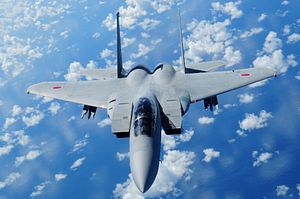For the first time in about 50 years, the Japan Air Self-Defense Force (JASDF) has stood up a new air wing consisting of Mitsubishi F-15J all-weather air superiority fighters at Naha Air Base, located in the capital city of Okinawa, Japan’s most southern prefecture, according to local media reports.
The stationing of additional fighter jets is part of Tokyo’s efforts to enhance the defenses of the Ryukyu Islands chain (known in Japanese as the Nansei islands), which stretches southwest from Kyushu to Taiwan. The push comes amidst China’s growing assertiveness and military presence in the East China Sea — Beijing and Tokyo both claim sovereignty over a group of uninhabited islands there, known in Japan as the Senkakus and in China as the Diaoyus.
As The Diplomat reported in October 2015, the JASDF had to dispatch its fighter jets 117 times against Chinese aircraft in the third quarter of 2015, up from 103 times in the same period in 2014. Most of the encounters occurred in the East China Sea. Overall, JASDF jets were scrambled 441 times from Naha Air Base in 2015, against mostly against incursions from the People’s Liberation Army Air Force (PLAAF).
The new JASDF unit, the 9th Air Wing, was officially stood up on Sunday during a ceremony at Naha Air Base, where Japan’s Parliamentary Vice Minister of Defense Kenji Wakamiya handed the flag for the new air wing to the unit’s commander, Kiyoaki Kawanami, NHK World reports.
“This is a very front line of national defense,” Wakamiya said in a speech during the ceremony. Japan dispatched 20 additional F-15J fighter jets from Tsuiki Air Base in the southwestern island of Kyushu to Naha, bringing up the total strength of the new air wing in Okinawa to 40.
Japan currently fields around 215 F-15J (including the upgraded F-15DJ/F-15J Kai versions) all-weather air superiority fighters built under license by Japanese defense contractor Mitsubishi Heavy Industries. However, despite modernization efforts, there have been concerns that the F-15J, first introduced in the JASDF in 1981, is no longer adequate to deter the PLAAF.
“The F-15J is essentially a USAF F-15 circa 1990. While Japan buys strike fighters, the air superiority role has withered. The two missions are different but complementary. Japan needs F-35 but it needs F-15 modernized to USAF standard as well,” said the aviation expert Steven Ganyard in an interview with Defense News.
As I reported previously, the JASDF might face a shortage of fighter jets in the 2020s, unless Tokyo accelerates upgrading its fleet of legacy aircraft and expands the scope of current modernization efforts.
The United States Air Force has also recently increased the number of aircraft stationed on Okinawa. According to media reports, the Pentagon last week dispatched 12 F-16 fighter jets and 14 F-22 aircraft to Kadena Air Base where they will stay until the end of the month.































